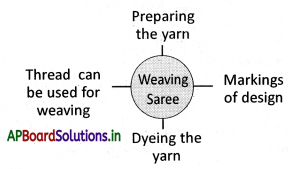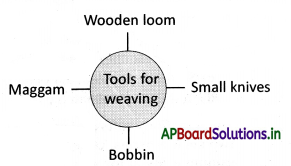Students can go through AP State Board 7th Class Social Studies Notes Chapter 7 Handicrafts and Handlooms to understand and remember the concept easily.
AP State Board Syllabus 7th Class Social Studies Notes Chapter 7 Handicrafts and Handlooms
→ Polish is a basket maker from Shankavaram village in Kanigiri Mandal, Prakasam District. He belongs to Yerukala, a tribal community.
→ Polish uses the spines of wild date palm (Eatha Chettu) leaves.
→ Shankavaram is about 80 km from Ongole’
→ Basket making is craftwork that involves the use of wild date palm leaves, cane, and bamboo, which are found in forests.
→ Forests due to their extensive exploitation for big industries.
→ Polish live in a slum, which does not have proper drainage, so it emits a foul smell and breeds mosquitoes and flies.
→ People of the Yerukula tribe are usually involved in basket making and live in different parts of Andhra Pradesh.
→ Dharmavaram is located in Anantapur district in the state of Andhra Pradesh.
→ Recently Dharmavaram sarees received the patent right.
→ Farmers grow silkworms to produce cocoons on mulberry leaves from which silk yarn is made. & This silk yarn is locally called “Katcha Pattu”.
→ Weavers own the wooden loom which is the main tool for weaving.
→ Weaving saree is a hereditary occupation for Venkatesu’s family.
→ Andhra Pradesh has the second largest number of handlooms in the country, next only to West Bengal.
![]()
→ The buyers are spread all over the world and weavers do not have any direct contact with them.
→ The cooperative societies are meant to help the weavers in buying raw materials at a low price and to arrange for marketing of their cloth.
→ A large amount of handloom cloth materials in Andhra Pradesh are produced and marketed by master weavers and merchants.
→ Along with Dharmavaram, there are many amazing weavers in Andhra Pradesh at Uppada (East Godavari), Mangalagiri (Guntur), Ponduru (Srikakulam), Venkatagiri (Nellore), Chirala (Prakasam), and Srikalahasti (Chittoor).
→ 1. Raw materials: The substance used to make things is called raw material. The raw materials for basket making are wild date palm tree leaves
→ Jacquard Cards: A card that is used for designing sarees.
→ Sapporo: The process by which the raw silk is made convenient for warp and waft.
→ Katcha Pattu: Silk yarn which is obtained from the cocoon in reeling centers is locally called Katcha Pattu.
→ Patent: An official right to be the only person to make, use or sell a product. or an invention.
→ Warp – Weft: Warp is the yarn that goes from top to bottom and wefts are the yarns that go from left to right. We can notice that cloth has threads passing from top to down and sideways something like this #.
→ Tie & Dye: Foy dyeing, the silk yarn is taken off, but when dry, it is again stretched, partly opened, and tied again for dyeing, this process is repeated several times. For making sarees in different colors and shades, different methods of dyeing are followed.
→ Co-operative Societies: Some persons of one particular group (farmers, teachers, etc.,) form, like society to get financial benefits.
→ Yerukula: People of the Yerukula tribe are usuallý involved in basket making and live in different parts of Andhra Pradesh. They are called ‘Yerukula’ after their women’s traditional profession of fortune-telling Eruka Chepputa (Sodhi)
![]()
→ Sapporo: Making the raw silk convenient for warp (vertical threads) and weft (horizontal threads) is known as support
→ Eruka Chepputa: Eruka is called Sodi’ Which means ‘predicting future with the help of ‘Souls’ ‘Eruka Chepputa’ is the word of ‘Erukala Sanaa

